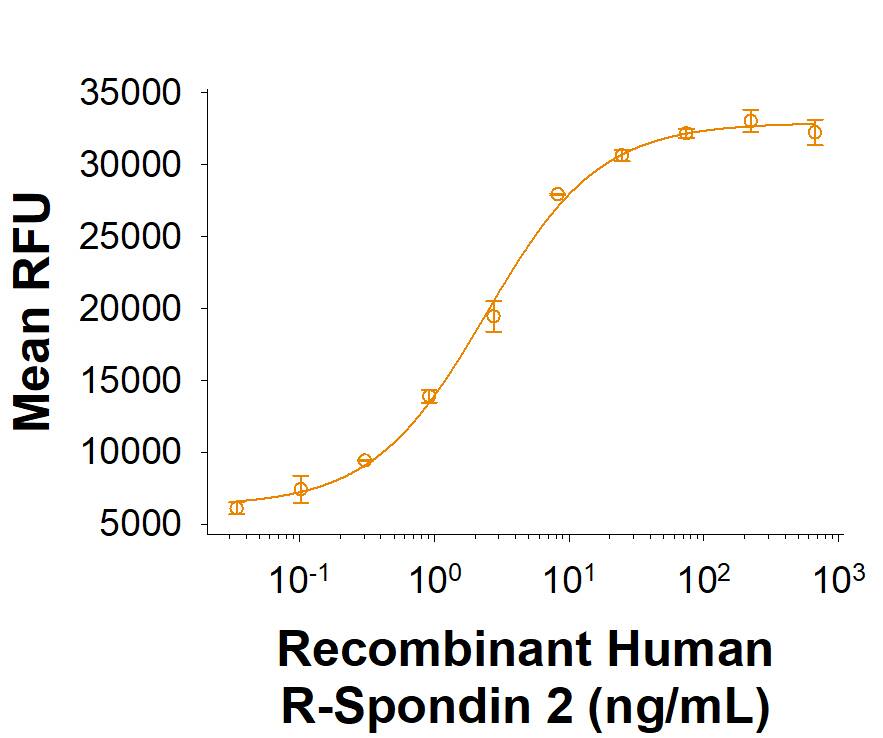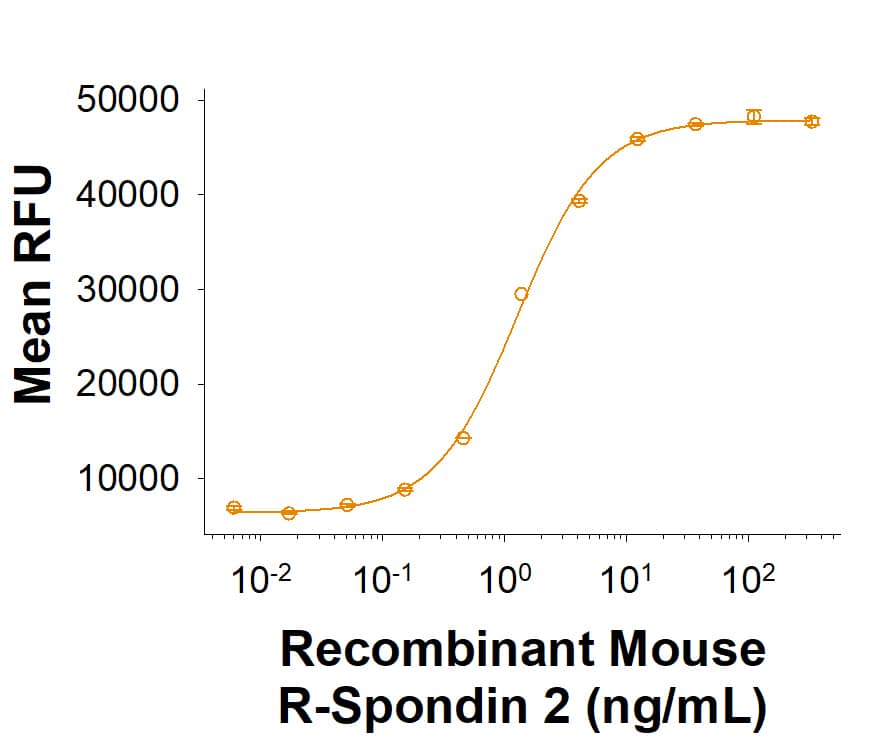R-Spondin 2: Proteins and Enzymes
R-Spondin 2 (RSPO2, Roof plate-specific Spondin 2), also known as cysteine-rich and single thrombospondin domain containing protein 2 (Cristin 2), is a 33 kDa secreted protein that belongs to the R-Spondin family. The four known human R-Spondins regulate ß-catenin signaling and overlap in expression and function. Like other R-Spondins, R-Spondin 2 contains two adjacent cysteine-rich furin-like domains (aa 90-134) followed by a thrombospondin (TSP-1) motif (aa 144-204) and a C-terminal region rich in basic residues (aa 207-243). The basic region appears to mediate cell surface retention but not to influence function (1). R-Spondin 2 contains one potential N-glycosylation site. Of the three reported splice isoforms of human R-Spondin 2, isoform 2 lacks residues 1-67 of isoform 1, while isoform 3 has a glycine substitution for residues 32-95 of isoform 1. Human R-Spondin 2 is expressed in organs of endodermal origin in adults, including intestine and lung, and is downregulated in tumors of these tissues. In the embryonic mouse, R-Spondin 2 is expressed most highly in the hippocampus and in developing teeth and bones. Studies in Xenopus and mouse embryos indicate that R-Spondin 2 is an extracellular activator of Wnt/ß-catenin signaling and is required for myogenesis. Mouse R-Spondin proteins bind both LRP-6 and Frizzled-8 but do not appear to form a ternary complex (3). R-Spondin 2 over-expression in Xenopus also blocks signaling of TGF-beta ligands, activin, nodal and BMP-4 (1). Human R-Spondin 2 is highly conserved across species, sharing 97-98% aa identity with mouse, rat, canine, bovine, and opossum R-Spondin 2 and 86% aa identity with Xenopus R-Spondin 2 within aa 22-205. Mature R-Spondin 2 shares ~40% aa identity with R-Spondin 1, R-Spondin 3, and R-Spondin 4.
4 results for "R-Spondin 2 Proteins and Enzymes" in Products
4 results for "R-Spondin 2 Proteins and Enzymes" in Products
R-Spondin 2: Proteins and Enzymes
R-Spondin 2 (RSPO2, Roof plate-specific Spondin 2), also known as cysteine-rich and single thrombospondin domain containing protein 2 (Cristin 2), is a 33 kDa secreted protein that belongs to the R-Spondin family. The four known human R-Spondins regulate ß-catenin signaling and overlap in expression and function. Like other R-Spondins, R-Spondin 2 contains two adjacent cysteine-rich furin-like domains (aa 90-134) followed by a thrombospondin (TSP-1) motif (aa 144-204) and a C-terminal region rich in basic residues (aa 207-243). The basic region appears to mediate cell surface retention but not to influence function (1). R-Spondin 2 contains one potential N-glycosylation site. Of the three reported splice isoforms of human R-Spondin 2, isoform 2 lacks residues 1-67 of isoform 1, while isoform 3 has a glycine substitution for residues 32-95 of isoform 1. Human R-Spondin 2 is expressed in organs of endodermal origin in adults, including intestine and lung, and is downregulated in tumors of these tissues. In the embryonic mouse, R-Spondin 2 is expressed most highly in the hippocampus and in developing teeth and bones. Studies in Xenopus and mouse embryos indicate that R-Spondin 2 is an extracellular activator of Wnt/ß-catenin signaling and is required for myogenesis. Mouse R-Spondin proteins bind both LRP-6 and Frizzled-8 but do not appear to form a ternary complex (3). R-Spondin 2 over-expression in Xenopus also blocks signaling of TGF-beta ligands, activin, nodal and BMP-4 (1). Human R-Spondin 2 is highly conserved across species, sharing 97-98% aa identity with mouse, rat, canine, bovine, and opossum R-Spondin 2 and 86% aa identity with Xenopus R-Spondin 2 within aa 22-205. Mature R-Spondin 2 shares ~40% aa identity with R-Spondin 1, R-Spondin 3, and R-Spondin 4.
| Source: | NS0 |
| Accession #: | NP_848660.2 |
| Applications: | BA |
| Source: | CHO |
| Accession #: | NP_766403 |
| Applications: | BA |
| Source: | CHO |
| Accession #: | Q6UXX9.2 |
| Applications: | BA |
| Source: | CHO |
| Applications: | BA |




